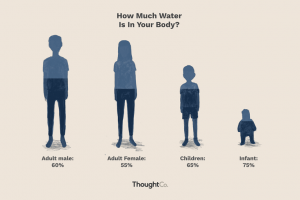Facts About Water

Here are some facts about water:
- Babies and children have a higher percentage of water than adults. When babies are born, they are about 78 percent water, but this falls to 65 percent by the age of 1 year.

-
- Fatty tissue has less water than lean tissue.
-
- Men have more water than women, as a percentage.
-
- 2.2 billion people still do not have access to safe drinking water.
-
- Safe water means having water at home, whenever needed, and free from contamination.
-
- 4.2 billion people – more than half of the world – do not have access to safe sanitation, meaning a toilet that separates human waste from contact, and a system to ensure that the waste is safely disposed of.
-
- 673 million people practice open defecation, meaning they go out on the side of the road, in fields or bushes because they don’t have access to water.
-
- Every day, over 700 children die from diarrhoea linked to unsafe water, sanitation and hygiene.
-
- In the world’s least developed countries, 17 million women give birth in health centres with inadequate water, sanitation and hygiene – putting them at risk of infection, disease and death.
-
- Handwashing with soap and water is one of the simplest and most effective ways to prevent the spread of disease. But 3 billion people still don’t have basic handwashing facilities with soap and water at home. That’s more than a third of the world’s population.
-
- The changing climate is destroying, drying up and contaminating water sources. By 2040, 600 million children will live in areas of water stress, unless we act now.
-
- 8 out of 10 people who lack even basic drinking water live in rural areas. 7 out of 10 people who lack even basic sanitation live in rural areas. 9 out of 10 people who practice open defecation live in rural areas.
-
- The world is not on track to meet the Sustainable Development Goal 6: access to safe water, sanitation and hygiene for all. UNICEF calls for greater political prioritization and increased funding to improve household access to water, sanitation and hygiene, targeting communities most at risk.
Leave a comment